Arachnids have diversified into virtually every terrestrial environment, with a few freshwater and marine representatives. Most are predators, but some are phytophages and others are obligate parasites of animals or plants (Harvey 2002). Jean Baptiste de Monet, Chevalier de Lamarck created the Arachnida in 1802, when he split Linnaeus's heterogenous group Insecta into three classes. The words “spider“, “scorpion“ and “mite“ are known to everyone everywhere (Savory 1964). For many people, long-legged spiders, venomous scorpions and blood-sucking ticks are the stuff of nightmares, but to others they are a source of constant fascination. The class Arachnida includes about 7 % of all the known animal biodiversity of the world (Zhang 2011). The number of orders recognized within the Arachnida has changed over time and between researches. The current concensus of 10 non-acarine orders seems to be holding firm, but the number of recognized acarine orders varies from one to six. In most of the arachnid orders there is to be found a characteristic feature which is peculiar to that order and to no other, thus: Scorpiones alone have pectines, Pseudoscorpiones alone have cheliceral silk glands, Opiliones alone have prosomatic odoriferous glands, Uropygi alone secrete acetic acid, Schizomida alone have a short telson, Araneida alone have opisthosomatic silk glands, Solifugae alone have racket-organs, Ricinulei alone have sex organs on their legs, Acari alone have vegetarian and parasitic forms (Savory 1964). Many arachnids evoke fear and loathing in human cultures, but the most are harmless to humans and are rarely seen by non-biologists.

|
Acari |
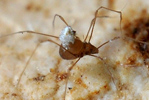 |
54,763
extant species |
opisthosomal segmentation indistinct; the prosoma and opisthosoma are fused |

|
|
|
Amblypygi |
|
161
|
|
opisthosomal segmentation visible, body flattened, opisthosoma lacks a terminal flagellum, palps raptorial |

|
|
Araneae |
|
47,645
|
opisthosomal segmentation indistinct; the prosoma and opisthosoma are distinct, palps simple |

|
|
|
Opiliones |
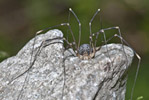 |
6,653
|
opisthosomal segmentation visible, opisthosoma lacks a terminal flagellum, palps usually simple; the prosoma and opisthosoma are distinct |

|
|
|
Palpigradi |
|
82
|
opisthosomal segmentation visible, opisthosoma with a terminal flagellum, palps simple |

|
|
|
Pseudoscorpiones |
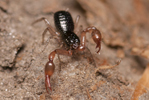 |
3,454
|
opisthosomal segmentation visible, opisthosoma lacks a elongate tail, palps chelate |

|
|
|
Ricinulei |
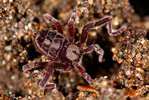 |
58
|
|
opisthosomal segmentation visible, prosoma with a separate sclerite (cucullus) anterior to the carapace, oval opisthosoma lacks a terminal flagellum, palps chelate |

|
|
Schizomida |
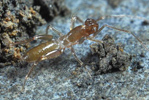 |
260
|
opisthosomal segmentation visible, opisthosoma with a short terminal flagellum, palps robust and simple, antennae-like first pair of legs |

|
|
|
Scorpiones |
|
2,323
|
|
opisthosomal segmentation visible, opisthosoma elongate (metasoma) and ending with a stinger, palps chelate |

|
|
Solifugae |
|
1,113
|
|
opisthosomal segmentation visible, opisthosoma lacks a terminal flagellum, palps simple, chelicerae large |

|
|
Thelyphonida |
|
110
|
|
opisthosomal segmentation visible, opisthosoma with a terminal flagellum; palps raptorial |

|

|
morphology |
|
The chief external feature of Arachnida is the division of the body into two parts, properly to be called the prosoma and the opisthosoma. The former is often called the cephalothorax, the latter is known as the abdomen. The objection to the use of these terms is that they are also in use for other animals, in which their constitution is not the same as in arachnids. The prosoma [pro] appears be made up of six somites, and each somite carries a pair of appendages, which are present in all Arachnida without exception. The dorsal plates or tergites of the prosoma are usually fused to form a carapace or epistome [epi]. The opisthosoma a maximum of 12 somites is recognizable. It is typically divided into a mesosoma [mes] and metasoma [met], although this is only clearly visible in scorpions, and in some orders, the abdominal sections are completely fused. In general the opisthosoma carries no appendages, but mesosoma of certain fossil arachnids bears obvious gills [zp]. In many arachnids the prosoma and opisthosoma are broadly joined, while in others they are joined by a narrow stalklike pedicel (modified 7th somite). |
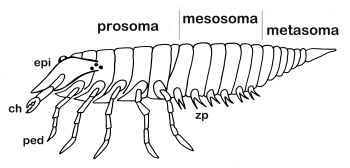 basic characteristics of arachnids' hypothetic ancestor
basic characteristics of arachnids' hypothetic ancestor© Martin Mrva (in: Matis et al. 2003) |
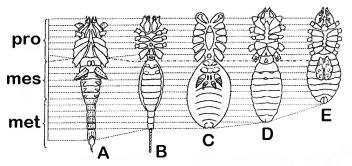 arachnid morphology: A - Scorpiones, B - Thelyphonida, C - Araneae, D - Solifugae,
arachnid morphology: A - Scorpiones, B - Thelyphonida, C - Araneae, D - Solifugae, E - Opiliones. Dotted line indicates 7th somite. © Martin Mrva (in: Matis et al. 2003) |
The first pair of appendages, the chelicerae [ch], serve in feeding and defense. The chelicerae consist of two or three segments. In Pseudoscorpiones they contain silk gland and in Araneae, poison. The next pair of appendages, the pedipalps [ped], have been adapted for feeding, locomotion, and/or reproductive functions. The pedipalpi consist of six segments. The limbs themselves may be simple tactile organs outwardly resembling the legs (as in spiders), or chelate weapons of great size (scorpions and false-scorpions). They may be specialized in different ways, as in spiders where they act as accessory male organ, and in Solifugae, where they terminate in suckers. The legs are of six segments – coxa, trochanter, femur, patella, tibia and tarsus. They may be all alike (and this is the general rule), but in some orders, notably Amblypygi and Solifugae, the first pair are not used for walking but are carried aloft and directed forwards as tactile organs. |
|
phylogeny |
|
After approximately 50 years of discussion most morphologists, palaeontologists and molecular taxonomists agree that the Arachnida are a monophylum. Arachnids possess a deep and extensive fossil record (Garwood & Dunlop 2014). Arachnid monophyly is supported by at least 11 synapomorphies (Coddington et al. 2004). Inside the arachnids, Xiphosura, Ricinulei, and Scorpiones possess the primitive characters. Almost all studies support the monophyly of Tetrapulmonata. The positions of Palpigradi, Opiliones, Ricinulei, and Acari are poorly resolved. Previous molecular studies confirm the non-monophyletic origin of mites (there are two orders Parasitiformes and Acariformes). There are some systematic conflicts in the phylogenetic information, particularly affecting the orders Acariformes, Parasitiformes and Pseudoscorpiones, which have had much faster evolutionary rates (Sharma et al. 2014). Idealized hypothetical arachnid phylogenetic tree and glossary of arachnid phylogenetic clades: |
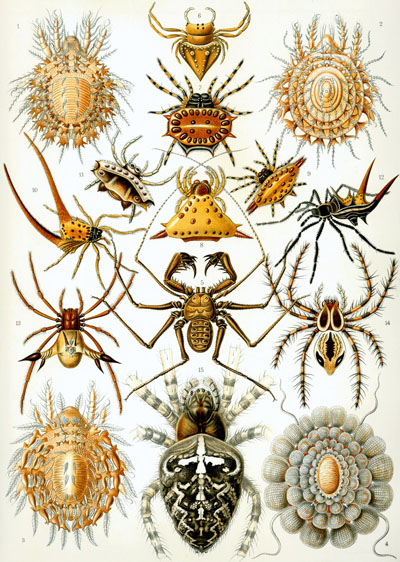 Ernst Haeckel: Kunstformen der Natur, Plate 66 (1904) |
 |
Acaromorpha = Ricinulei + Acari |
Coddington, J.A., Giribet, G., Harvey, M.S., Prendini, L., Walter, D.E. 2004. Arachnida. In: Cracraft, J., Donoghue, M.J. (eds) Assembling the Tree of Life. Oxford University Press, pp. 296–318.
Garwood, R.J., Dunlop, J. 2014. Three-dimensional reconstruction and the phylogeny of extinct chelicerate orders. PeerJ 2: e641, p. 1–33.
Harvey, M.S. 2002. The neglected cousins: what do we know about the smaller arachnid orders? The Journal of Arachnology 30: 357–372.
Harvey, M.S. 2013a. Palpigrades of the World, version 1.0. Western Australian Museum, Perth, online at http://www.museum.wa.gov.au/catalogues/palpigrades, accessed on 15. October 2016.
Harvey, M.S. 2013b. Pseudoscorpions of the World, version 3.0. Western Australian Museum, Perth, online at http://museum.wa.gov.au/catalogues/pseudoscorpions, accessed on 15. October 2016.
Harvey, M.S. 2013c. Ricinuleids of the World, version 1.0. Western Australian Museum, Perth, online at http://www.museum.wa.gov.au/catalogues/ricinuleids, accessed on 15. October 2016.
Harvey, M.S. 2013d. Schizomids of the World, version 1.0. Western Australian Museum, Perth, online at http://www.museum.wa.gov.au/catalogues/schizomids, accessed on 15. October 2016.
Harvey, M.S. 2013e. Solifuges of the World, version 1.0. Western Australian Museum, Perth, online at http://www.museum.wa.gov.au/catalogues/solifuges, accessed on 15. October 2016.
Harvey, M.S. 2013f. Whip scorpions of the World, version 1.0. Western Australian Museum, Perth, online at http://www.museum.wa.gov.au/catalogues/whip-scorpions, accessed on 15. October 2016.
Harvey, M.S. 2013g. Whip spiders of the World, version 1.0. Western Australian Museum, Perth, online at http://www.museum.wa.gov.au/catalogues/whip-spiders, accessed on 15. October 2016.
Kury, A.B. 2002. Checklist of valid genera of Opiliones of the World. Museu Nacional/UFRJ website. Online at: http://www.museunacional.ufrj.br/mndi/Aracnologia/checklaniator.htm, accessed on 5. April 2017.
Kury, A.B. 2018. Classification of Opiliones. Museu Nacional/UFRJ website. Online at: http://www.museunacional.ufrj.br/mndi/Aracnologia/opiliones.html, accessed on 10. November 2018.
Lamarck, J.B.P.A. de 1801. Système des animaux sans vertèbres. Lamarck et Deterville, Paris.
Matis, D., Krumpál, M., Beláková, A., Fedor, P. 2003. Zoológia bezchordátov 2 diel. Tentaculata, Pogonophora, Onychophora, Arthropoda, Hemichordata, Echinodermata. Vysokoškolské učebné texty pre prírodovedecké fakulty, Faunima, Bratislava, 168 pp.
Rein, J.O. 2016. The Scorpion Files. NTNU, online at: https://www.ntnu.no/ub/scorpion-files/, accessed on 5. April 2017.
Savory, T.H. 1964. Arachnida. Academic Press Inc., 291 pp.
Schmidt, K.-H. 2010. AcariBase - database of mites with more than 58.000 names, online at http://www.miteresearch.org/index1.html, accessed on 17. October 2016.
Sharma, P.P., Kaluziak, S.T., Pérez-Porro, A.R., González, V.L., Hormiga, G., Wheeler, W.C., Giribet, G. 2014. Phylogenomic Interrogation of Arachnida Reveals Systemic Conflicts in Phylogenetic Signal. Molecular Biology and Evolution 31 (11): 2963–2984.
Word Spider Catalog 2018. World Spider Catalog. Natural History Museum Bern, online at http://wsc.nmbe.ch, version 19.5, accessed on 27. July 2018.
Zhang, Z.-Q. 2011. Phylum Arthropoda von Siebold, 1848 In: Zhang, Z.-Q. (Ed.) Animal biodiversity:
An outline of higher-level classification and survey of taxonomic richness. Zootaxa 3148: 7–12.
![]()
|
|
| © 2016 Slovak Arachnological Society |
| Last updated: 30th March 2019 |
|
|

